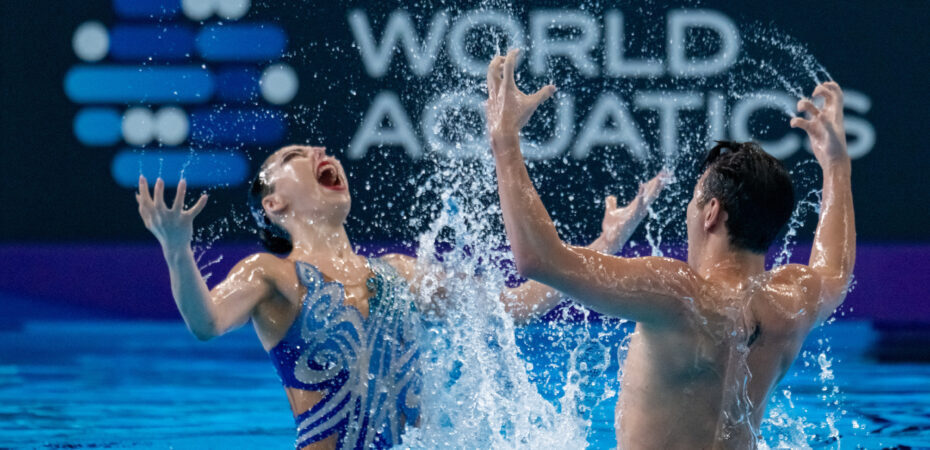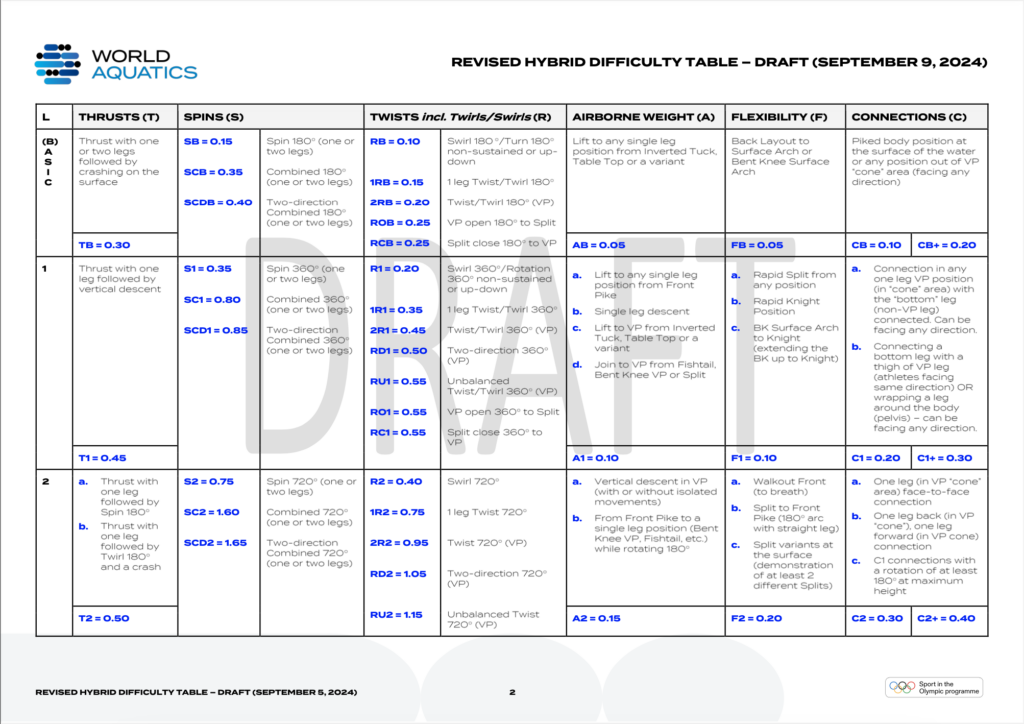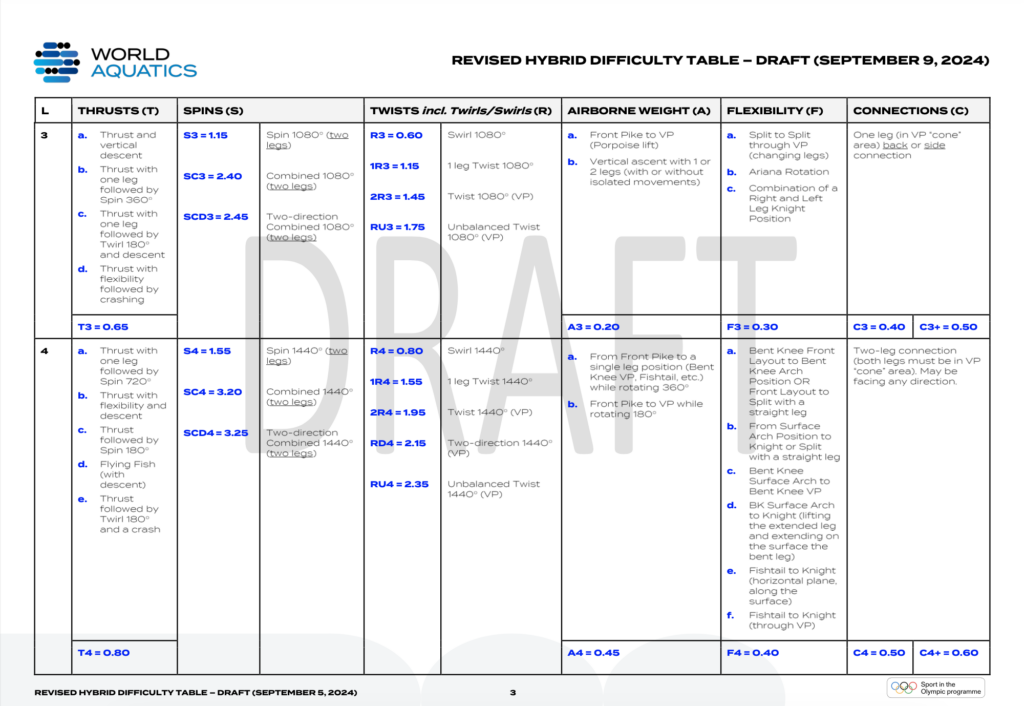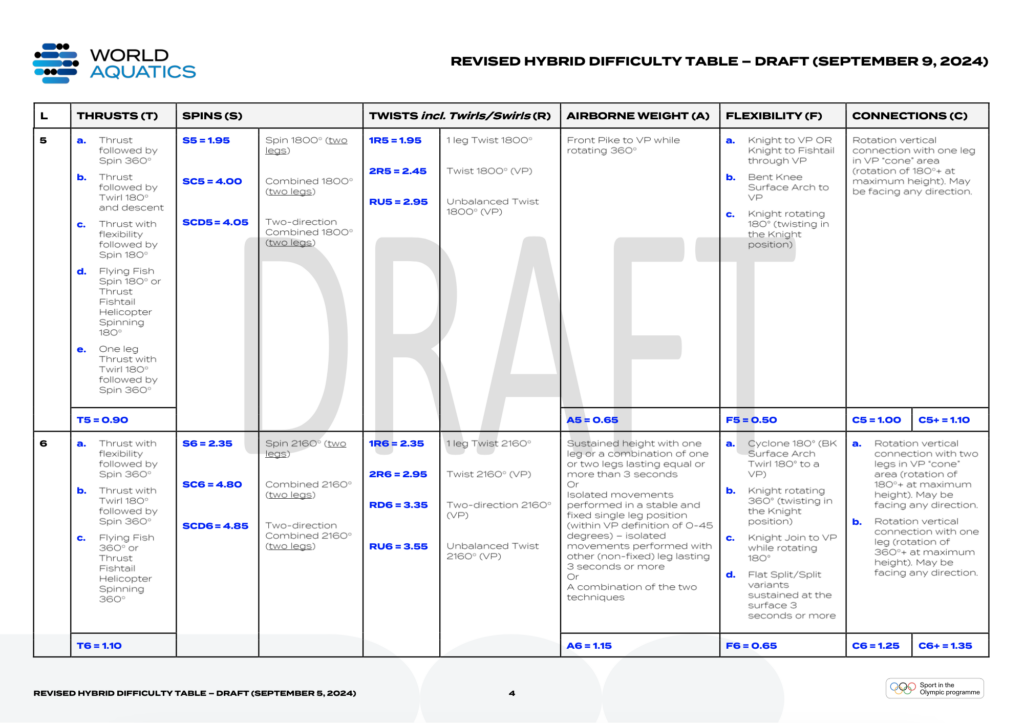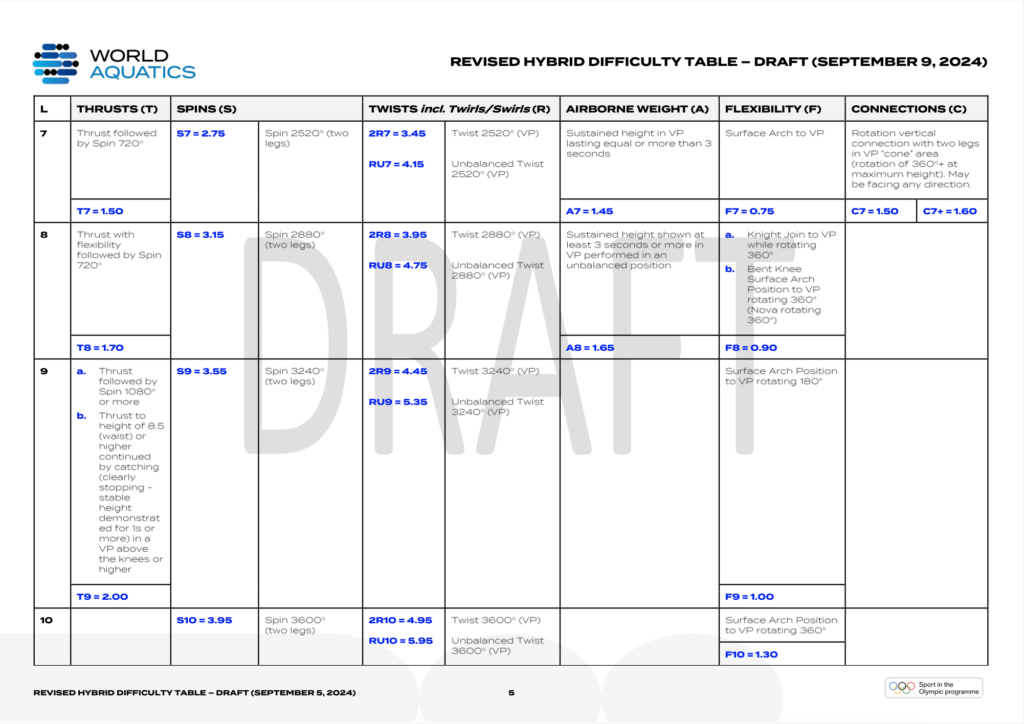New season, new rules! Heading into 2025, artistic swimming routines are set to look a little different than the last two years.
With fewer required elements, more restrictions to encourage variety, and an overall stronger focus on transitions and performance quality, expect routines that feel less rushed and more creative.
As the first World Cup of the season will soon be on the horizon, here’s what you need to know about what’s coming next, and what you should notice in the water.
Please note that this is a summary of the most significant changes and not an exhaustive list — more specifics can be found in the updated rules, manuals and appendices.
Overall Changes
Fewer Required Elements
For the last two seasons, each routine has had a set number of Elements. Elements can be the technical required elements, free hybrids, and acrobatics. Essentially, one is only allowed to do so many things in a routine.
Heading into the 2025 season, fewer Elements are now required across all routines except for the Acrobatic Team (JR/SR) and Free Combination (U12/Youth). In most cases, it often means one less Free Hybrid.
With fewer Elements to do but the time of each routine remaining unchanged, this means more breathing room (also, literally) in the routine for transitions, choreography, performance, emotions, etc.
Updated Number of Total Required Elements (JR/SR) for 2025:
- Solo Technical: 7 → 6
- Solo Free: 7 → 6
- Duet Technical: 8 → 7
- Duet Free: 9 → 8
- Mixed Duet Technical: 8 → 7
- Mixed Duet Free: 9 → 7
- Team Technical: 9 → 8
- Team Free: 11 → 9
- Team Acrobatic: 7 = 7
In parallel, the factors of the three categories that make up the Artistic Impression (AI) score — Choreography and Musicality, Performance, Transitions — are anticipated to be revised to better balance the total score, and thus give AI a stronger weight.
In particular, the factors for Transitions in each routine should be adjusted significantly with these latest rule changes. For example, at the Spanish National Championships for Junior Technical Routines in November, the transitions’ factors were increased from 1.0 to 2.0 in solo and duets, and to 2.2 in team.
The U12 and Youth age groups also see reductions and changes in their Total Required Elements. While we will not go into those as extensively here, please note the addition of a “Team Choreography Hybrid” in the Free Combination requirements, which is virtually the equivalent of the “Creative Hybrid” that Spain had implemented domestically last season in the U12 and Youth routines (read more).
Revised Technical Required Elements (TRE) and Youth Figures
Usually, Figures and Technical Required Elements (TRE) are changed every four years, after the World Championships held in the year following the Olympic Games. However, some minor adjustments have already been made at this time.
In the junior and senior technical events, two TREs have been modified: one in the Women’s Duet and the other in the Mixed Duet.
In the former, TRE 3 has been changed to encourage better height and improve the overall flow of the routine. The DD is of 2.6. For the synchro nerds, the new TRE 3 is: Beginning from Ballet Leg Position – Flamingo Bent Knee rollback – Join to Vertical Position – Half Twist – 360° Open to Split – Walkout.
The TRE 3 also changes for the mixed duet and is now a Manta Ray Half Twist. It may look familiar, as the technical team routine during the 2017 – 2021 cycle featured a nearly similar TRE, save for a minor difference in the rotation. Moreover, TREs 4 and 5 for the mixed duet have also been removed (more on that below).
Three new Figures appear in the Youth category, as changes were deemed necessary to better balance the new groups of Figures that were introduced for the 2023 season and on. This will also help judges look for similar skills across the two groups of figures within the same section.
As a result, one figure in Section A (Group 1) has been modified, while two figures in Section C (Groups 5 and 6) have been revised.
No more apnea limits
The limits on the time spent in apnea during Free Hybrids – previously applicable at the Junior, Youth and U12 levels – as well as the 40-point bonus for respecting said-limits, have been removed.
With fewer Elements required, as well as an anticipated stronger emphasis on artistic impression and higher factoring of transitions, these limits had become obsolete.
Harsher penalties
The same violations as before are penalized, but the value of some of these penalties will increase. That way, penalties will actually impact the final score – which is much higher in this open-ended scoring system than before – and to discourage people from doing things they shouldn’t, thinking it won’t make a big difference.
Penalties for the more significant violations are anticipated to be raised to 8.0 points. For example, for timing violations such as the deckwork exceeding 10 seconds, or the total music time not respecting the ± 5 seconds allowance, teams should now receive an eight-point penalty. A routine can also be penalized eight points if an athlete deliberately uses the bottom of the pool, or if the acro in technical team exceeds the maximum DD of 3.0, amongst others.
Penalties have been reviewed in many other areas, and some didn’t change, but, all in all, do not be surprised if you notice a higher total under penalties on the scoresheet or on your screen as you watch a competition.
Changes to the Mixed Duet
Moving into the 2025 season, the Mixed Duet routines should look different from what we have seen so far under the new rules. This specific event has undergone a significant overhaul, with different and fewer requirements.
The goal is simple: to offer a different style of routine, with a higher focus on choreography, expressivity and connection between the two athletes.
The Mixed Duet Technical routine is undoubtedly the one that sees the most changes, with fewer TREs and different required Elements.
In this event, athletes now have to showcase seven Required Elements, most notably with only three TREs instead of five. The first and second TRE are unchanged, the third has been modified as mentioned previously, and the fourth and fifth have been removed.
In addition, they must show one Free Hybrid, one Required Hybrid and two Pair Acrobatics. Three Sustained Surface Connections – coded “SuCon” on the Coach Card – with travel (1m or more) or rotation (180°) must also be shown. They do not count towards the total number of required elements, nor the DD of the routine, but they are mandatory.
The Required Hybrid is completely new. For this hybrid, coaches can only declare one Thrust and two different Connections. The rest of the hybrid can have other movements, and these do not even have to be synchronized. These extra movements simply will not be declared, and thus will not count towards the DD. That said, this hybrid can be used to boost the artistic impression score.
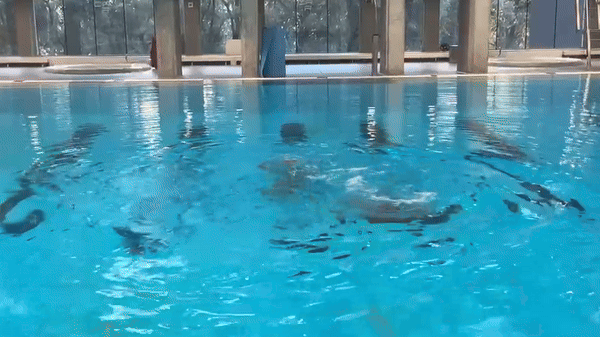
The sustained surface connections (“SuCon”) were already a requirement these last two years in the Mixed Duet Free routines, but they did not have to be declared, although the Technical Controllers were obviously looking for them.
From now on, on the Coach Card, the “SuCon” will be declared in the transition that contains it just to help the controllers. Again, it has no DD associated so the Elements panel will not score it. Its complexity and execution will be considered in the Transitions score by the AI judges.
Finally, a lot more flexibility is possible as to how everything can be done in this technical routine. Like in the Team Technical and Duet Technical, the three TREs must still be performed simultaneously and facing the same direction.
However, everything else, i.e. the deckwork and entry into the water, Free Hybrids, transitions, and Pair Acrobatics, do not have this restriction and may be performed freely. Such freedom is not possible in the other technical events.
In the Mixed Duet Free routine, only seven Elements are required as well, a decrease from nine in the past. Again, this is to encourage artistic impression, transitions, and more interaction between the man and the woman in the water.
Four Free Hybrids and three Pair Acrobatics must be performed, as well as a minimum of four Sustained Surface Connections, which must also be declared on the Coach Card.
Changes to the Difficulty Table for Free Hybrids
New definition of Free Hybrids
Firstly, what is a Free Hybrid has changed. Before, a Free Hybrid was considered to be two movements or more. Now, it is defined as having a combination of five or more movements performed with lower limbs with intentional apnea.
Anything with four or less movements, with or without intentional apnea, is now considered a transition.
Over the last two seasons, it appeared many didn’t want to risk doing any transitional hybrids, so this new definition and differentiation between the two should encourage short and more interesting transitions.
Revised Families
There are now six families of movements that can make up a Free Hybrid. Each family still has different levels of difficulty, ranging from a new Basic Level (B) up to Level 10.
The former “Rotations” family has essentially been split in two to better differentiate between Spins (ascending, descending or combined) and Twists (rotations at the same height). Say goodbye to R7 as you knew it.
- Thrusts (TB – T9)
- Spins (SB – S10)
- Twists, including Twirls/Swirls (RB – R10)
- Airborne Weight (AB – A8)
- Flexibility (FB – F10)
- Connections (CB – C7)
New Levels & Codes
As mentioned, a new level was introduced at the start of the difficulty table: a Basic Level. For example, a Spin at the Basic level (SB) is considered a Spin 180° with one or two legs. It is worth 0.15. Level 10 is also a new level, only appearing for the Spins, Twists and Flexibility families, and should be more likely featured in solos and duets.
Although some families are obviously carried over from the last two seasons, everything within each family has been better defined, with new codes created and new values applied. Every movement now has its own code, or even sub-code, with its own numerical value.
In some families, like Thrust, a few movements are grouped in the same level – each with different codes but the same value. For example in Level 4, a Thrust with flexibility and descent is written as T4b. A Thrust followed by a Spin 180° goes by T4c. Both are worth 0.80.
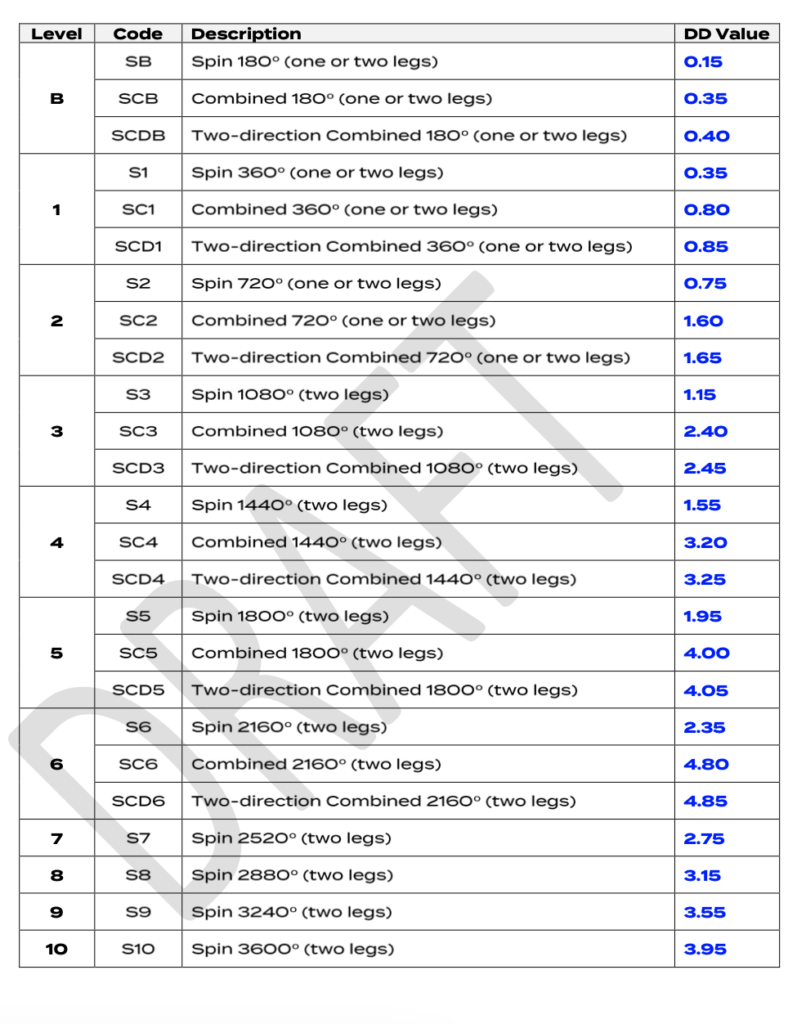
In the Spins or Twists families, we see different codes for different values. These codes are a bit more extensive, but fairly easy to grasp. For example in the Spins Level 5 family, a Spin 1800° is S5 (1.95). A Spin Combined 1800° is SC5 (4.00). A Spin Combined Two-Direction 1800° is SCD5 (4.05).
Only one Bonus left
All Bonuses have been removed except for Pattern Change, which is worth 0.20. Naturally, it is a bonus only applicable to Team Technical, Team Free and Free Combination.
The disappearance of bonuses means that fans may see the return of some beloved moves. For example, proper, long and artistic cadences in the Team Technical routine – where a cadence is a requirement – may finally be back since the Full Synchronization bonus has disappeared.
Height matters even more
Height has become an important factor in a few families, and an actual requirement to avoid a basemark. For example, the minimum height for anything in the Thrusts or Spins families to be credited is an execution score of 3.5.
For the Thrusts family, this means above the knees. Any declared Thrust that doesn’t reach this minimum height will immediately go to basemark. For the Spins and Twists families, a minimum height of 3.5 usually means slightly below the knee.

On top of it, height is also important to receive credit in the higher difficulty levels. Per the new difficulty table, a T9 will only get credited if the thrust reaches a height of 8.5, so waist-level.
So, if a soloist has declared any T9 but only boosts to about hip-level, the height requirement is hence not met, and the hybrid will receive a basemark, no matter the execution.
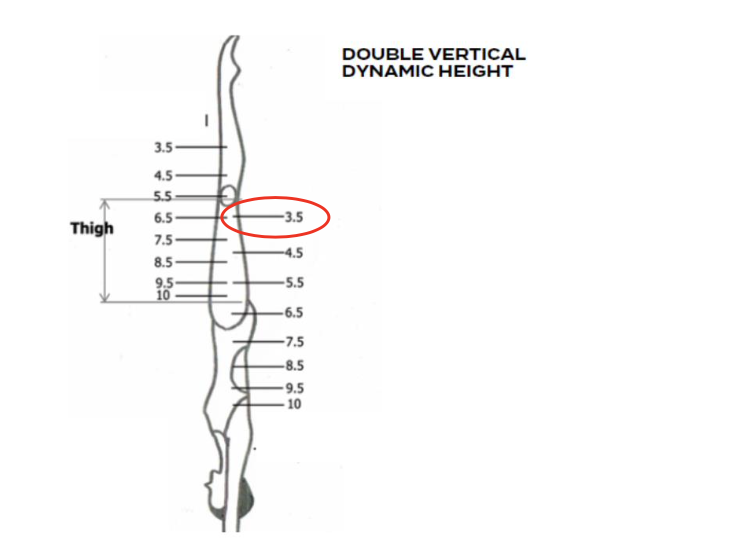
DD begins with basemark value of 0.5
The calculation of a Free Hybrid’s Degree of Difficulty (DD) has also been slightly modified, as the basemark value of 0.5 is now added to the total DD.
While this will not change what fans see in the water, it is a good thing to keep in mind when the first few DDs are announced in the upcoming season. That, plus the modification of the difficulty table, naturally means it is incorrect to compare the DDs, or scores, between 2024 and 2025, for example.
Hybrid DD = Basemark (0.5) + Movements (Families) + Bonus (Team only)
Other limits and requirements
Finally, each free routine must include a skill from every family (except for Connections in solo, of course), or it will result in a hefty penalty. Not all families have to be present in the free hybrid(s) of the technical routines.
There is also a maximum of 5 declarations per family per hybrid, with a limit of 3 times per technique. For example, you can declare five R movements in one hybrid in this way: 2R1 2R1 2R1 RO1 RO1. Declaring 2R1 2R1 2R1 2R1 RO1 is not possible.
These limits are naturally implemented to encourage variety in hybrids.
Draft of the new Difficulty Table as of September 2024 (click to enlarge)
Changes to Acrobatics
Overall, the acrobatics catalog has been streamlined for 2025, making things much easier for athletes, coaches, and judges alike.
Subgroups within the four main acrobatic groups (A, B, C, P) are gone, and the DD for acrobatics no longer depends on the number of swimmers involved. For example, what was once split into ‘small’ and ‘big’ constructions now shares a single code, like “St.”, which further eliminates the risk of basemarks due to mis-declarations.
The same acrobatic cannot be performed more than once in a routine
The biggest change from the updated acrobatics manual is that acrobatics must not be repeated in the same routine. This is defined as follows:
- Group Airborne: cannot repeat the same position(s)* as P1 or P2 (exception for third position bonus) within a routine. For example, a team cannot declare a 2.5 back somersault and a 1.5 back somersault in the same routine if the featured swimmer is in a tuck position for both.
- Group Balance: cannot repeat the same construction or type of connection/grip within a routine.
- Group Combined: cannot repeat the same construction within a routine.
- Group Platform: cannot repeat the same construction, type of connection/grip, or position(s) (as explained in the A example but with positions from the B group) within a routine. Essentially, teams need to go for completely different platforms.
While positions cannot be repeated in multiple acrobatics from the same group within a routine, they can be performed in acrobatics from different groups. For example, it is possible to do a ‘Bamboo’ position in both a Balance and a Platform acrobatic in the same routine.
Further limitations in Team Acrobatic routine
The number of required Elements in the Team Acrobatic routine stays the same, with seven acrobatics required: one from each group (A, B, C and P) and three “free choice”.
However, on top of the aforementioned limitation to not repeat the same acrobatic, a maximum of 2 acrobatics from any group may be performed. This means that, for example, a team cannot do three Platforms (P) in its acrobatic routine.
DD begins with basemark value of 0.5 or 0.1
Similarly to the new starting value for Free Hybrids, DD now begins with a basemark value of 0.5 for all team acrobatics, or 0.1 for all pair acrobatics.
Additional difficulty from other parts of the acrobatic calculation algorithm is added on top of this value. That algorithm remains the same.
Specifications for positions
Positions must be clearly demonstrated in order to avoid going to basemark — this means that there must be a clear pause in the declared position(s). Positions requiring hand captures/grabs must be performed clearly and with control.
Any position clearly shown above the height allowance (knees for head-up positions, waist for head-down positions, and full body out of the water for horizontal positions) must be declared. However, transitional positions (no clear stop, such as going through vertical) do not need to be declared.
Stricter allowances
Overall, allowances for acrobatics have been revised and made stricter.
In Group A for 360° rotations, an allowance of 180° is tolerated as before. However, there is no more allowance for 180° rotations. Performing less than 180° is a basemark.
For rotations of the construction of the base in groups B and C, there is no longer a 180° allowance for a 360° rotation. The new allowance for rotations of 360° or more is only 90° less than declared. For a 180° rotation, there is no longer any allowance. Over-rotation (more than declared) is still permitted.
In any type of handstand connection, arms must remain in the vertical cone above the head (allowance of 45°) from the beginning to end of the acrobatic movement.

Furthermore, there is now a 45° allowance for the featured swimmer performing a position in a handstand.
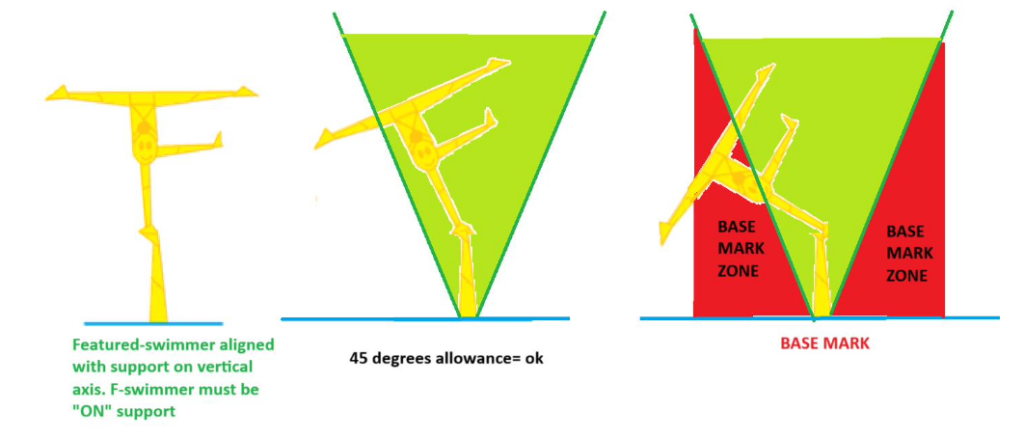
Pair acrobatics
New pair acrobatics (with updated DDs) have been added to the catalogue. Again, these all have a “starting” basemark value of 0.1.
Allowances have also been revised:
For somersaults:
- 90° less than declared is a basemark.
- 360° somersaults must be fully visible above the water.
- Over-rotating is permitted.
For twists:
- In head-down lifts/throws, rotations are counted until the kneecaps of the featured swimmer.
- In head-up lifts/jumps, rotations are counted until the waist-level of the featured swimmer.
- 360° rotations have a 90° allowance. 180° rotations have no allowance. Over-rotating is permitted.
Finally, an important clarification was made for when declaring a jump/throw for a pair acrobatic. It is now mandatory to see the full body out of the water and a clear disconnection of the Featured Swimmer from the Support Swimmer. Otherwise it will be considered as a lift, and the acro will go to basemark.
All updated documents should soon be available on World Aquatics.
ARTICLE BY CHRISTINA MARMET & MARI FLORES
Cover photo: Giorgio Scala / Deepbluemedia
If you’ve enjoyed our coverage, please consider donating to Inside Synchro! Any amount helps us run the site and travel costs to cover meets during the season.

